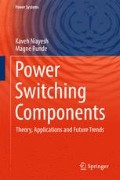Abstract
The previous chapters looked into various aspects of current interruption in conventional power grids including basic working principles and different applications of power switching components and technologies used in these devices. There has been a steady development of switching devices to increase their functionality, to add new features, to widen their application range and at the same time to reduce their production costs.
Access this chapter
Tax calculation will be finalised at checkout
Purchases are for personal use only
References
Gentsch D, Goettlich S, Wember M, Lawall A, Anger N, Taylor E (2014) Interruption performance at frequency 50 or 60 Hz for generator breaker equipped with vacuum interrupters. In: Proceedings of XXVI international symposium on discharges and electrical insulation in vacuum. Mumbai, India, pp 429–432
Schellekens H, Gaudart G (2007) Compact high voltage vacuum circuit breakers, a feasibility study. IEEE Trans Dielectr Electr Insul 14(3):613–619
Liu X, Lai Z, Cao Y, Liu X, Zou J (2011) Research on insulation characteristics of multi-break in series extra high voltage vacuum circuit breaker. In: Proceedings of the 1st international conf. electric power equipment—switching technology. Xian, China, pp. 44–47
Is-limiter: the world fastest limiting and switching device, ABB product catalogue
Schmitt H et al (2012) Application and feasibility of fault current limiters in power systems, Cigre WG A3.23 report no. 497, June 2012
Paul W, Chen M (1998) Superconducting control for surge currents. In: IEEE Spectrum, May 1998, pp 49–54
Noe M, Hobl A, Tixador P, Martini L, Dutoit B (2012) Conceptual design of a 24 kV, 1 kA resistive superconducting fault current limiter. IEEE Trans Appl Supercond 22(3):5600304
Moscrop JW (2013) Experimental analysis of the magnetic flux characteristics of saturated core fault current limiters. IEEE Trans Magn 49(2):874–882
Yuan J et al (2015) Performance investigation of a novel permanent magnet biased fault current limiter. IEEE Trans Magn 51(11):1–4
Abramovitz A, Smedley KM, De la Rosa F, Moriconi F (2013) Prototyping and testing of 15 kV/1.2 kA saturable core HTS fault current limiter. IEEE Trans Power Delivery 28(3):1271–1279
Abramovitz A, Smedley KM (2012) Survey of solid-state fault current limiters. IEEE Trans Power Electron 27(6):2770–2782
Dordizadeh P, Gharghabi P, Niayesh K (2011) Dynamic analysis of a fast acting circuit breaker drive mechanism. J Korean Phys Soc 59(6):3547–3554
Callavik M, Blomberg A, Häfner J, Jacobson B (2012) The hybrid HVDC breaker: an innovation breakthrough enabling reliable HVDC grids. In: ABB grid systems, Technical paper, Nov 2012
Preve C et al (2016) Validation method and comparison of SF6 alternative gases. D1-205, CIGRE
Seeger M (2016) Survey on SF6 alternative gases for switching. CIGRE SC A3, Paris
Saxegaard M et al (2015) Dielectric properties of gases suitable for secondary medium voltage switchgear. 0926, CIRED
Hyrenbach M et al (2015) Alternative gas insulation in medium-voltage switchgear. 0587, CIRED
Kieffel Y et al (2016) Green gas to replace SF6 in electrical grids. IEEE Power Energ Mag 14(2):32–39
Author information
Authors and Affiliations
Corresponding author
Rights and permissions
Copyright information
© 2017 Springer International Publishing AG
About this chapter
Cite this chapter
Niayesh, K., Runde, M. (2017). Future Trends and Developments of Power Switching Devices. In: Power Switching Components. Power Systems. Springer, Cham. https://doi.org/10.1007/978-3-319-51460-4_6
Download citation
DOI: https://doi.org/10.1007/978-3-319-51460-4_6
Published:
Publisher Name: Springer, Cham
Print ISBN: 978-3-319-51459-8
Online ISBN: 978-3-319-51460-4
eBook Packages: EnergyEnergy (R0)

